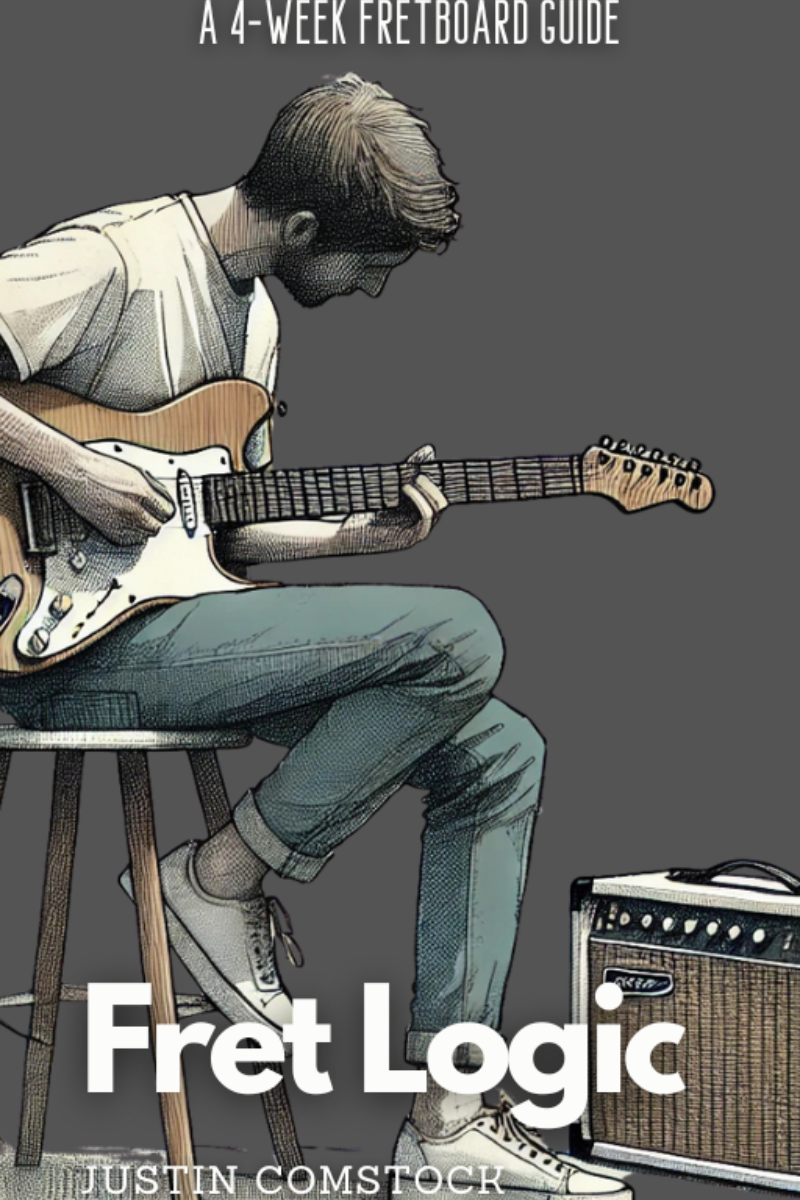If guitar playing is a language, then the minor pentatonic scale is its most essential vocabulary. Whether you’re bending blues notes, shredding rock solos, or layering soulful melodies, this five-note scale is your foundation—the one scale you must master.
In this post, we’ll explore:
- What makes the minor pentatonic scale so iconic
- How to construct it and visualize it all over the fretboard
- Essential phrasing techniques for expressive playing
- Genre-specific applications: blues, rock, funk, jazz‑fusion
- A powerful 30-minute practice routine you can do every day
- And how FretDeck™ makes all of this easier—and faster
By the end, you’ll know how to unlock the scale’s full power… and start sounding musical, confident, and practiced—fast.

❌ Stop Guessing. Start Shredding.
If you’re still fumbling through scale patterns and box shapes… it’s costing you progress.
FretDeck™ is the no-fluff system that shows you exactly how to master the fretboard—fast. Early access.
⚡️ This isn’t for dabblers. It’s for players who want results.
👉 Click here to join the pre-launch now
Early access. Limited rewards. Don’t wait.
1. What Is the Minor Pentatonic Scale? (And Why You Should Care)
Minimal, melodic, and timeless.
The minor pentatonic scale—root, b3, 4, 5, b7—is the most used scale in guitar history. It’s the backbone of legendary solos like “Whole Lotta Love” and “Back in Black.” Its simplicity isn’t its weakness, it’s its strength.
In the key of A minor, the scale is:
- A (root)
- C (minor third)
- D (perfect fourth)
- E (perfect fifth)
- G (minor seventh)
That 5‑note structure gives the scale an open, soulful character: enough tension to sound edgy, but enough space to stay musical. Let’s break it down…
2. Constructing the Scale: A Proof in Patterns
Rather than memorize notes, learn the positions. Here’s the classic A minor pentatonic box at the 5th fret:
|----------------5--8--|
B|-----------5--8-------|
G|--------5--7----------|
D|-----5--7-------------|
A|--5--7----------------|
E|----------------5--8--|
That pattern slides and repeats across the fretboard. The secret to mastery isn’t knowing five positions—it’s owning the first one until your fingers know it blindfolded.
Want to master all five positions—and the tricky middle ones? Here’s the fast‑track:
- Learn CAGED positions with each pentatonic box
- Connect them with FretDeck™ so you can visualize the scale instantly—any key, any position
When you can run that pattern on command, you stop playing shapes and start playing music.
3. Five Proven Phrasing Tricks That Make You Sound Pro
Knowing the notes is just tip‑tap. Let’s make them sing.
3.1 🔹 String Bends
Bent notes say “pain,” “pleasure,” and “voice.”
Grab the 7th fret on G, bend to G → A: an emotional leap—one of the most powerful tools on the guitar.
3.2 🔹 Slides
Make your lines gel.
Slide into 5th → 7th fret on D, let it flow instead of popping each note.
3.3 🔹 Double‑Stops
Two strings harmonizing = instant soul.
Try D+G strings on 5th and 7th frets—simultaneous bending intensifies expression.
3.4 🔹 Vibrato
You’ve heard solos breathe—this is it.
Add subtle wobbles to longer notes—especially on your bends—for lasting emotional weight.
3.5 🔹 Call‑and‑Response
Play a lick, pause, then answer—like a conversation:
Light phrase → Big bend → Resolve to root note.
Practice prompt:
Jam over an A minor backing track—play a four-note lick, pause, then answer it. Smart phrasing = musical soloing.
4. Style Breakdown: Applying It Across Genres
A. Blues
Start simple: root–b5–root over a dominant progression.
Drive home with bending and double stops.
B. Rock
Leverage power chords under your pentatonic lines.
Use more aggressive phrasing and upper-register notes for bite.
C. Funk / R&B
Focus on rhythmic phrasing and muted double-stops, add chromatic neighbor tones for funk vibe.
D. Country / Americana
Use short, tasteful bends, open-string intervals, and slides in major pentatonic to add flavor.
E. Fusion/Jazz
Overlay the minor pentatonic on modal chords (e.g., Cmaj7#11).
Widen your harmonic palette with hybrid scales.
Want to connect those dots fast?
FretDeck™ comes with a “Genre Fusion” expansion—connect pentatonic phrasing to jazz voicings, alt-bends, and melodic lines. It’s the missing link from box‑shaped playing to expressive, ear‑trained solos.
5. The 30‑Minute Daily Routine to Master Pentatonic Soloing
Pick this up, glue it into your life—and watch your fingers start thinking for themselves.
🔥 5‑Minute Warm‑Up
Chromatic finger drills at 60 BPM → Hammers/pulls on pentatonic root shape.
🎸 7‑Minute Position Run
Play the 5th‑fret A‑minor box while saying note names aloud (or at least hearing them in your head).
🧩 7‑Minute Phrasing Practice
Spend one minute on each technique: bend, slide, double-stop, vibrato, call‑response
🎵 5‑Minute Ear Training
Play two scale tones—identify intervals (e.g., minor third, perfect fifth).
🎶 6‑Minute Improvisation
Jam over an A‑minor backing track. Use your phrasing toolkit. Record and listen back.
Do this 5x/week. Within 30 days, solos born from this routine will sound like yours.
6. When You’re Ready to Accelerate: FretDeck™ + Discord
You can do all this from YouTube. Or, you can shortcut it with FretDeck™—a visual, tactile toolkit purpose-built for guitar players who want real progress (not busy work).
🔗 Why FretDeck Works
- Instantly internalize pentatonic positions in any key
- Practice real solos and phrasing exercises with prompt cards
- Build musical muscle memory for tone, technique, and confidence
🎯 Back FretDeck on Kickstarter today
Back now → Back FretDeck™ on Kickstarter
💬 What You’ll Get As A Backer
- Full pentatonic deck covering all 60 patterns
- Practice prompt pack to refine phrasing
- Stretch goal: Genre Fusion Deck (jazz, rock, funk)*
- Access to Guitar Freaks Hangout Discord—community of players learning together

❌ Stop Guessing. Start Shredding.
If you’re still fumbling through scale patterns and box shapes… it’s costing you progress.
FretDeck™ is the no-fluff system that shows you exactly how to master the fretboard—fast. Early access.
⚡️ This isn’t for dabblers. It’s for players who want results.
👉 Click here to join the pre-launch now
Early access. Limited rewards. Don’t wait.
7. Join the Guitar Freaks Hangout Discord Community
Soloing mastery starts with practice—and thrives within a community.
Inside the Guitar Freaks Hangout, you’ll:
- Share daily jam clips
- Complete soloing challenges
- Swap tricks and phrasing ideas
- Receive constructive feedback
- Access Q&A sessions with me
Join us today → Join Guitar Freaks Hangout Discord
🎁 Bonus: get 5 free chapters of SoloCraft + bonus practice cards instantly.

Join Guitar Freaks Hangout on Discord! 🎸
Get Fret Logic FREE!
Join the Guitar Freaks Hangout Discord and get exclusive access to my entire e-book, Fret Logic! Master the fretboard and elevate your solos with this comprehensive guide.
👉 Don’t miss out—join now and download your free copy!
Final Word: The Minor Pentatonic Is Your Lifelong Companion
You’ve just uncovered one of guitar’s best-kept secrets:
Start simple. Practice with purpose. Build phrase by phrase.
Whether you’re spitting blues flair, ripping rock leads, weaving soulful riffs—or composing your next masterpiece—the minor pentatonic scale is your foundation.
Want to turn fundamentals into flair?
- Practice the 30‑minute routine 3‑5 times per week
- Master that first box (and more with FretDeck™)
- Use 5 key phrasing techniques every session
- Record. Reflect. Improve.
- Accelerate progress by joining Guitar Freaks and backing FretDeck™
You don’t need to learn 50 scales. You need to own one.
🔗 Useful Internal Links
Want to quickly move past just one pentatonic box? Learn how to connect all five positions and truly master the neck: How to Master the Guitar Fretboard Fast.










